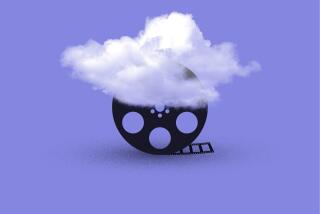Thumbs Down on Bad Habits
- Share via
It turns out that the previous brainstorm of Dr. Alfred Barrios was just a stress rehearsal.
Barrios, you may or may not recall, is the local clinical psychologist who came up four years ago with a Stress Control Biofeedback Card.
Its principle was simple enough, based on the fact that clammy hands often indicate tension. “When your defenses are up, your blood tends to go inward to your muscles and vital organs, and at that point your hands grow cold,” he said.
He designed a credit-card-size device, impregnated with temperature-sensitive crystals, which a person pressed with his or her thumb for 10 seconds. The card showed black for stressed, red for tense, green for normal and blue for relaxed.
It was thumbs up on thumbs down.
Millions Sold
Barrios said the card, which was marketed for $3.95 with a 14-page booklet of explanations and tips, sold in the millions--”although many copied versions of the card started appearing.”
Now here you are, presumably all laid back and mellow--but cracking your knuckles, interrupting conversations, swearing, gulping junk food, oversleeping.
All of them bad habits, buster, and if you had any sense you would run out and buy the Habit Buster, newly developed by Barrios at his Self-Programmed Control Center Inc. in Culver City. This, too, is a kit ($4.95) which includes a thumb-sensitive card and a booklet.
Here it is just a few weeks after the start of the new year, and the odds are, according to Barrios, that you have already broken your New Year resolutions.
“The reason is that because once bad habits are programmed in--and resolutions usually deal with intending to break bad habits--they become difficult to change.”
Barrios, who has a doctorate in psychology from UCLA, gave as an example someone who vows he isn’t going to eat as much or smoke as much.
“Before you know it, you’ve got that cigarette in your hand or that snack in your mouth. You have automatically done it before you are even consciously aware of what you are doing.”
Innumerable Bad Habits
There are, of course, innumerable other habits, and the psychologist offered thoughts on some:
- Oversleeping: “It could be that the person is just tired. But oversleeping could also be an escape, the person doesn’t want to face certain things that day--perhaps going to the dentist, maybe going to work.”
- Junk Food Overeating: “One reason some people snack a lot on these foods is that this acts as a tranquilizer.”
- Knuckle Cracking: “This might be a habit, per se. The person originally has, as a child, possibly seen someone doing it. And habits can be kept going because they satisfy the need for pleasure, or the need to relax, or they are programmed in to occur automatically, even though there is no need. Leaving the cap off the toothpaste is another example.”
- Procrastination: “One reason for this may be that the thing put off might be painful, such as the paying of bills or a student facing the writing of a term paper.”
Barrios himself owned up to a bad habit, which he said he is overcoming by using one of the methods in his own guidebook.
“When driving, I have a tendency not to come to a complete stop at stop signs,” he said. He is conquering this bad habit, he said, by self-programming through the use of mental pictures. This capability, he writes in his book, was first discovered by physiologist Ivan Pavlov, who called it Higher Order Conditioning.
“I have written down on a piece of paper typical corners where I don’t come to a complete stop,” Barrios continued. “I have mentally pictured myself driving up to the stop signs. Rather than rolling, I come to a complete halt, and look to the left and right.
“Now, when I am actually in my car, I have forgotten that I have gone through this process--but I find that I do come to a complete stop. It is as if a bell is ringing and reminding me.”
Another method he recommends is--instead of, say, reaching for a cigarette--to reach for the handy dandy Habit Buster card. Similar to the Stress Control card, the idea again is to have warm hands and get the blues.
“When you are stressed is usually the time when you will have the least self-control,” the psychologist explained. “And that is the time when you will most likely fall into destructive behavior patterns or habits.”
‘Take a Deep Breath’
In addition to mentioning the power of mental visualization, the card suggests: “When you feel the urge for your habit, take a deep breath, then let it out all at once, letting your body go completely loose and limp. Repeat until card is deep blue and urge has disappeared.”
Another secret of habit-hectoring, obviously, is willpower. Or, more accurately, won’tpower.
Here, courtesy of Barrios, who also is a lecturer, is a willpower technique which may never have occurred to you. Try it in an elevator, and get the car to yourself:
Extend both arms in front, at the same level. With your eyes closed, picture one arm being lifted by an attached balloon pulling up on it, the other arm holding a bucket full of water.
After 30 seconds or so of focusing on this image, open your eyes and check where your arms are. The greater the difference between your balloon arm and your bucket arm, the more in control you are and the easier it will be to say no to a bad habit, Barrios said.
He recommends practicing this technique until you can cause the arms to separate completely.
Thus, what with self-programming, use of deep breathing to relax, improving your willpower, there will henceforth be no excuse for interrupting, excessive TV watching, overspending, nail biting. . . .


